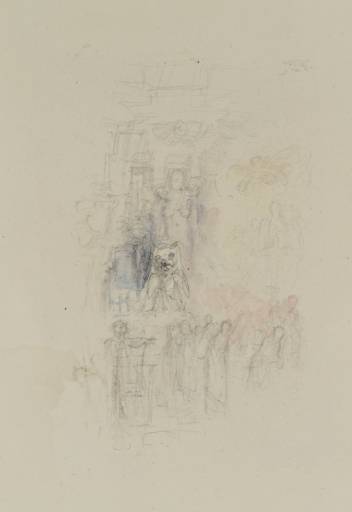Joseph Mallord William Turner Study for 'The Chaplet' for Moore's 'The Epicurean' c.1837-8
Joseph Mallord William Turner,
Study for 'The Chaplet' for Moore's 'The Epicurean'
c.1837-8
Joseph Mallord William Turner 1775–1851
Study for ‘The Chaplet’ for Moore’s ‘The Epicurean’ circa 1837–8
D27644
Turner Bequest CCLXXX 127
Turner Bequest CCLXXX 127
Crayon, pencil and watercolour, approximately 115 x 70 mm on three-ply laminated Foolscap Bristol drawing board, 379 x 292 mm
Inscribed by John Ruskin in red ink ‘127’ bottom right
Inscribed by an unknown hand in pencil ‘CCLXXX’ bottom right
Stamped in black ‘CCLXXX 127’ bottom right
Inscribed by John Ruskin in red ink ‘127’ bottom right
Inscribed by an unknown hand in pencil ‘CCLXXX’ bottom right
Stamped in black ‘CCLXXX 127’ bottom right
Accepted by the nation as part of the Turner Bequest 1856
References
1909
A.J. Finberg, A Complete Inventory of the Drawings in the Turner Bequest, London 1909, vol.II, p.898, as ‘A vision’.
1993
Jan Piggott, Turner’s Vignettes, exhibition catalogue, Tate Gallery, London 1993, p.96.
1999
Peter Bower, Turner’s Later Papers: A Study of the Manufacture, Selection and Use of his Drawing Papers 1820–1851, exhibition catalogue, Tate Gallery, London 1999, p.121 note 1.
This sketch belongs to a large group of preliminary studies which relate to Turner’s vignette illustrations for John Macrone’s 1839 edition of Thomas Moore’s The Epicurean, a Tale: and Alciphron, a Poem. The study resembles the style and dimensions of another work in this group (see Tate D27648; Turner Bequest CCLXXX 131) suggesting that Turner produced them at around the same time.
Jan Piggott has identified the subject as an experimental design for The Chaplet, circa 1838 (untraced),1 one of four vignettes that Turner produced for Moore’s fantastical prose tale The Epicurean.2 The finished watercolour, engraved for publication by Edward Goodall, depicts the trial of Alethe, a former pagan priestess who converts to Christianity, standing trial for heresy.3
Although her sentencing is delayed another day, the evil Orcus insists that she wear a coral chaplet that he has secretly poisoned:
Although her sentencing is delayed another day, the evil Orcus insists that she wear a coral chaplet that he has secretly poisoned:
The implacable Orcus, however, would not hear of mercy ... It was but by the firm intervention of the Governor, who shared the general sympathy in her fate, that the delay of another day was granted to give a chance to the young maiden of yet recalling her confession, and thus affording some pretext for saving her. Even in yielding, with evident reluctance, to this respite, the inhuman Priest would yet accompany it with some mark of his vengeance. Whether for the pleasure (observed the Tribune) of mingling mockery with his cruelty, or as a warning to her of the doom she must ultimately expect, he gave orders that there should be tied round her brow one of those chaplets of coral, with which it is the custom of young Christian maidens to array themselves on the day of their martyrdom
(Thomas Moore, The Epicurean, 1839, pp.205–6)
(Thomas Moore, The Epicurean, 1839, pp.205–6)
Despite his efforts, Alciphron is unable to remove the deadly band, and Alethe dies in his arms.
This sketch has been primarily executed in pencil with faint touches of watercolour wash. Although it is difficult to discern the exact subject, Turner is probably picturing the moment of Alethe’s sentencing. Several details correspond to the final illustration. The artist has indicated a high chamber with elaborate architectural features. Numerous figures crowd the bottom right-hand corner, whilst the scene is surveyed from above by winged angels bearing a cross. The central background is dominated by statues of a giant caryatid and a monstrous, bestial figure, probably the Egyptian god, Anubis, which in the finished version are pushed to the left-hand side of the composition.
This sketch has been primarily executed in pencil with faint touches of watercolour wash. Although it is difficult to discern the exact subject, Turner is probably picturing the moment of Alethe’s sentencing. Several details correspond to the final illustration. The artist has indicated a high chamber with elaborate architectural features. Numerous figures crowd the bottom right-hand corner, whilst the scene is surveyed from above by winged angels bearing a cross. The central background is dominated by statues of a giant caryatid and a monstrous, bestial figure, probably the Egyptian god, Anubis, which in the finished version are pushed to the left-hand side of the composition.
Technical notes:
Like many of Turner’s studies for Moore’s The Epicurean, this sketch has been made on three-ply Bristol board, a type of board sold by most artists’ colourmen. The support exhibits three watermarks, ‘Slade | 1836’, and a circular blind embossed stamp, ‘Bristol | [image of crown] | Board’ top left. The board has been laminated with handmade paper which has been trimmed to Foolscap size (nominally 15 x 12 inches). Peter Bower has identified the maker as the William & Thomas Slade Mill, the papermakers who succeeded William Allee at Hurstbourne Priors Mill in Hampshire.1
Like many of Turner’s studies for Moore’s The Epicurean, this sketch has been made on three-ply Bristol board, a type of board sold by most artists’ colourmen. The support exhibits three watermarks, ‘Slade | 1836’, and a circular blind embossed stamp, ‘Bristol | [image of crown] | Board’ top left. The board has been laminated with handmade paper which has been trimmed to Foolscap size (nominally 15 x 12 inches). Peter Bower has identified the maker as the William & Thomas Slade Mill, the papermakers who succeeded William Allee at Hurstbourne Priors Mill in Hampshire.1
Verso:
?Blank [partially pasted to mount]
Stamped in black ‘CCLXXX 127’ bottom right
Stamped in black ‘CCLXXX 127’ bottom right
Meredith Gamer
August 2006
How to cite
Meredith Gamer, ‘Study for ‘The Chaplet’ for Moore’s ‘The Epicurean’ c.1837–8 by Joseph Mallord William Turner’, catalogue entry, August 2006, in David Blayney Brown (ed.), J.M.W. Turner: Sketchbooks, Drawings and Watercolours, Tate Research Publication, December 2012, https://www

